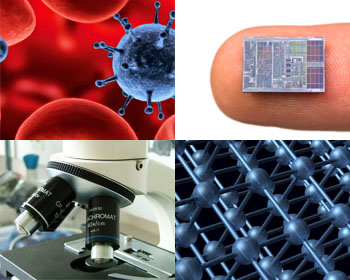A Publication of the
Applied Math and Science Education Repository

The AMSER Science Reader Monthly aims to provide educators with a useful package of information about a particular topic related to applied math and science by combining freely available articles from popular journals with curriculum, learning objects, and web sites from the AMSER portal. The AMSER Science Reader Monthly is free to use in the classroom and educators are encouraged to contact AMSER with suggestions for upcoming issues or comments and concerns at [email protected].
This month's AMSER Science Reader Monthly topic is Nanotechnology.
Can Nanotechnology Save Lives?
Article
by Michael Rosenwald
Synopsis and resource annotations by Max Grinnell

The world of nanotechnology is quite small. Not in terms of actual intellectual breadth or creativity, but by mere definition. Nanotechnology is the science of structures measuring between 1 nanometer (or a billionth of a meter) and 100 nanometers. The potential applications for nanotechnology have grown in recent years, and institutions and organizations around the world are trying to capitalize on new advances in this particular branch of science.
This article by Michael Rosenwald from the August 2010 edition of Smithsonian magazine profiles the work of Harvard Professor George Whitesides. Whitesides teaches chemistry and his work in the fields of biology, engineering, physiology, materials science, physics, and nanotechnology over the past several decades has been prolific. Through a discussion of Whitesides' discoveries, patents, and research, Rosenwald examines the science of nanotechnology and the consumer projects currently available that make use this type of technology. Whitesides' latest project, the so-called "lab on a chip," is the size of a postage stamp, designed to diagnose a variety of ailments with the precision of a high-tech laboratory. This device will allow health workers in the developing world to use a patient's blood or urine to detect one out of 16 of the most common ailments. Potentially, the health worker may be able to then send a photo of the stamp with a cellphone to a doctor for a tentative diagnosis.
The article goes on to discuss future nanotech projects, which may include ultrasensitive devices to detect oil, particles that can deliver medicine to kill a tumor, and batteries that could last months and power electric cars. In the final part of the article, Whitesides considers the direction of his own work and nanotechnology, "What I want to do is solve problems. And if nano is the right way of solving the problem, I'll use that. If something else is the right way, I'll use that." At the end of the article, readers will also find related links and a photo gallery to supplement the story.
Found below is a list of useful resources that will illuminate and enhance understanding of the topics found within this article. The first link will take visitors to Nanowerk, which includes up-to-date news about nanotechnology, nanotech resources, and job opportunities in the field. The second link leads to a great 10-minute video which can be used by educators to introduce students to nanotechnology. Moving on, the third link leads to a lesson from the NanoEd Resource Portal. The module teaches students about the interesting science that happens at the nanoscale, the tools used by scientists to study objects so small, and the potential applications of discoveries made in nanotechnology. The fourth link whisks users away to a site provided by the National Nanotechnology Infrastructure Network, which explains how nanotechnology is used in products like pants and tennis balls. The fifth link leads to Live Science's page on Nanotechnology, which details the future benefits that nanotechnology research could serve including advances in telecommunications, information technology, healthcare, and pharmaceuticals. The final link leads visitors to an online activity on the cell membrane and nanotechnology created by the Wisconsin Online Resource Center.



